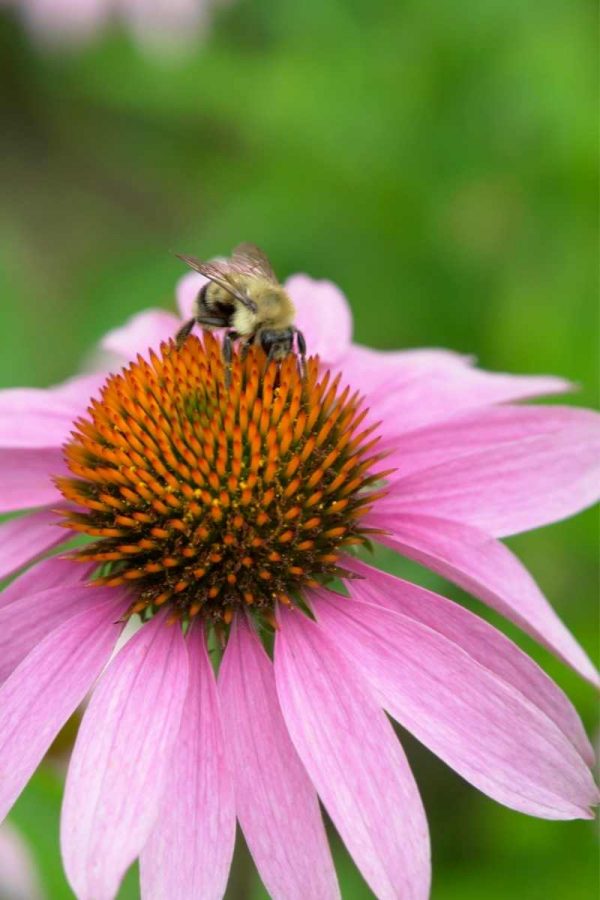The top varieties of coneflower to try in your garden. Whether you’re after showy petals or cone-shaped seed heads, there’s an echinacea variety for everyone!
Coneflowers (echinacea) are one of the best perennial additions to your garden! Not only are they gorgeous, but they are easy to care for, have wonderful medicinal purposes, and pollinators love them!
If you’re ready to dig into the joy of echinacea, keep reading for our list of the best coneflower varieties to add to your garden.
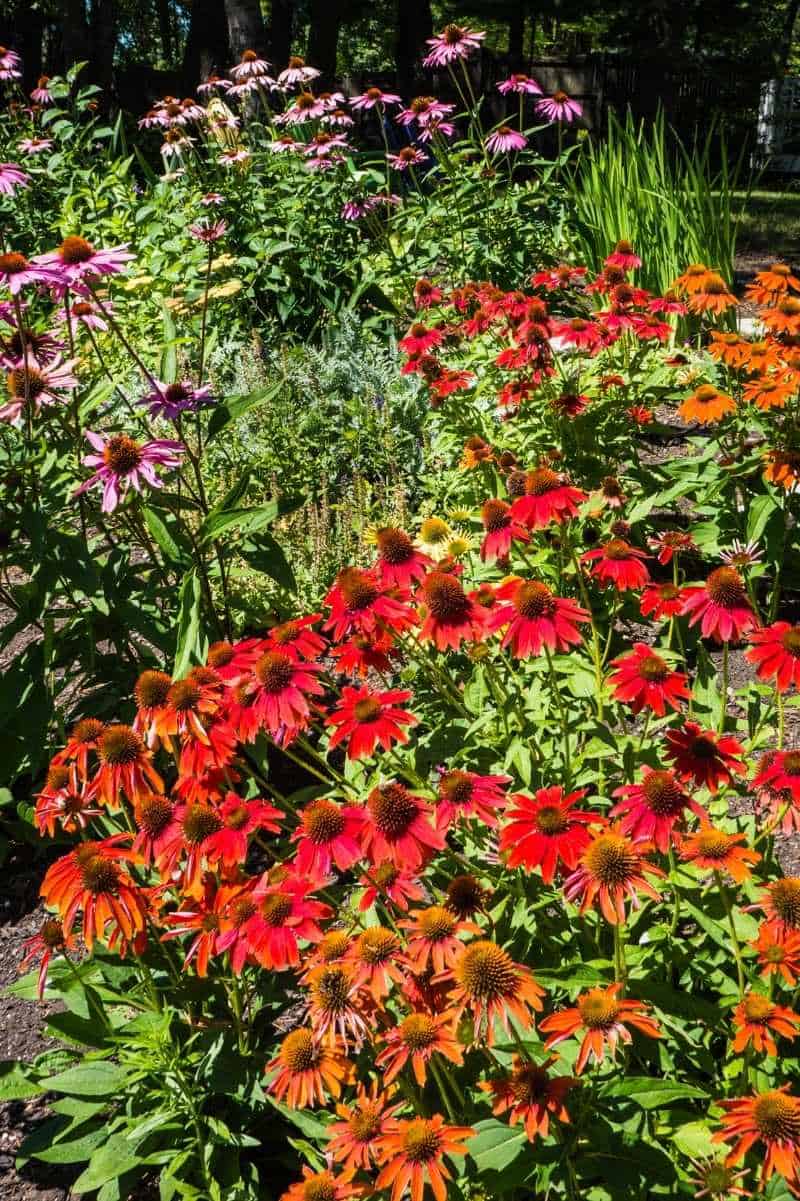
Table of Contents
Why should I grow coneflowers?
It can be tricky to find perennials with beautiful blooms that are also deer-resistant, but echinacea fit the bill! Coneflowers are also great for attracting pollinators like bees and butterflies, and the seeds are beloved by birds. These flowers are also native to North America, so gardeners trying to replant their space with native plants may want to include naturally-occurring echinacea varieties in full sun areas.
Coneflowers are also incredibly long-blooming perennials. Don’t be surprised if you get flowers from July to September (or even to the first frost)!
Echinacea is a wonderful plant to add to your garden if you are interested in home herbalism. Echinacea is a classic immune-support herb that can be made into teas, tinctures, and other homemade medicines to help your family get through cold and flu season.
Growfully Protip
If you are growing echinacea to use it for medicinal purposes, we recommend growing the classic purple echinacea plant—echinacea purpurea—it is the most well-studied of echinacea varieties for medicinal purposes.

Do coneflowers come back every year?
Yes! Coneflowers are perennials in zones 3-9. If you live in a hardiness zone at the far ends of that range, you’ll want to look at the hardiness of each particular variety to determine what will thrive best in your garden.
Where do coneflowers grow best?
Echinacea will thrive and put out the best flowers in full sun, though they can handle a small amount of shade in either the early morning or late afternoon. Because they can grow to be several feet tall, coneflowers can provide shade for low-growing perennials.
Coneflowers aren’t super picky about their soil quality (we’ve had coneflowers grow right out of our gravel driveway!), but they do not tolerate wet soil well. Plant echinacea in well-draining soil. Echinacea is drought-tolerant—meaning it’ll grow even during the driest of growing seasons.
We prefer to start echinacea plants indoors about 8 weeks before our last frost date, then plant out the coneflower seedlings about 18-24″ apart. Water regularly until the plant is established.
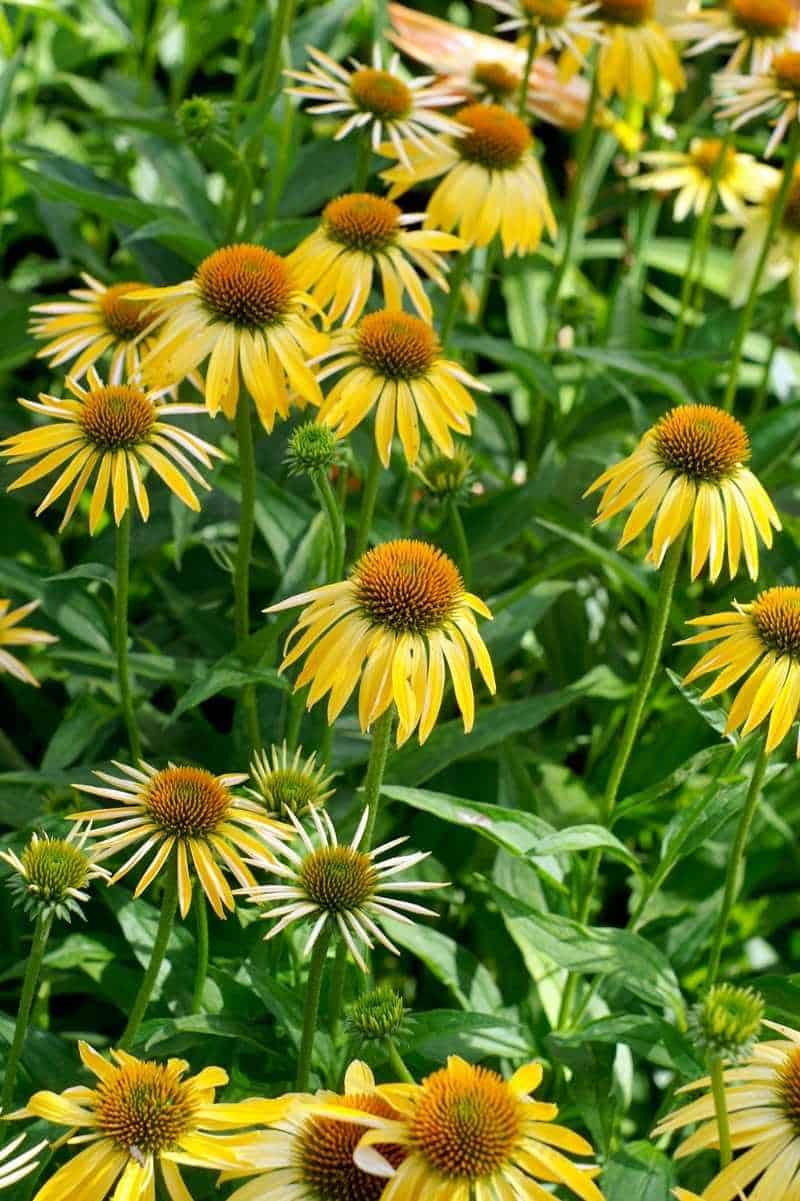
Does echinacea spread?
Not really. You can expect a coneflower plant to get larger in its first few years, but because it is a clumping plant, it will not spread beyond where you first plant it.
Growfully Protip
Coneflowers will self-seed—but not in a rampant way that some self-seeding flowers will. You might find a few new coneflower seedlings around your original plant come spring.
Should I deadhead my echinacea?
Deadheading can help get more blooms out of your coneflower throughout the season, but it absolutely isn’t necessary to have good blooming. We prefer to deadhead to save seeds and keep the plant looking tidy. At the end of the season, leave a few flowers intact on the stems. The seeds will help keep wild birds fed throughout the winter!
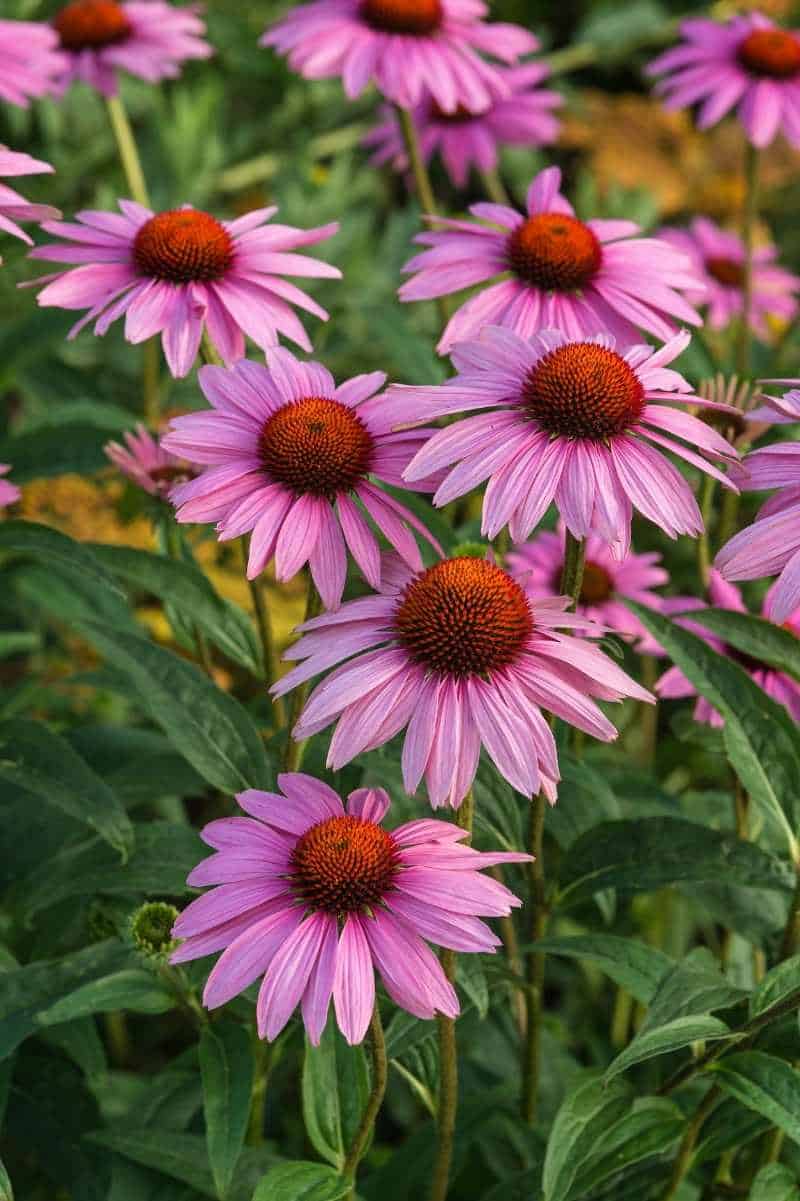
13 Coneflower Varieties
While the coneflowers most people are familiar with are either purple or white, there are actually many varieties of coneflower in a wide array of colors. These are some of our favorites:
Native Varieties
We recommend planting coneflower varieties that are native to your area. Not only are these plants going to be the easiest to grow in your area, but they are also the best natural food for pollinators near you. Native plants are awesome! There are over 10 distinct species of native echinacea in the United States. Here are some common options to try:
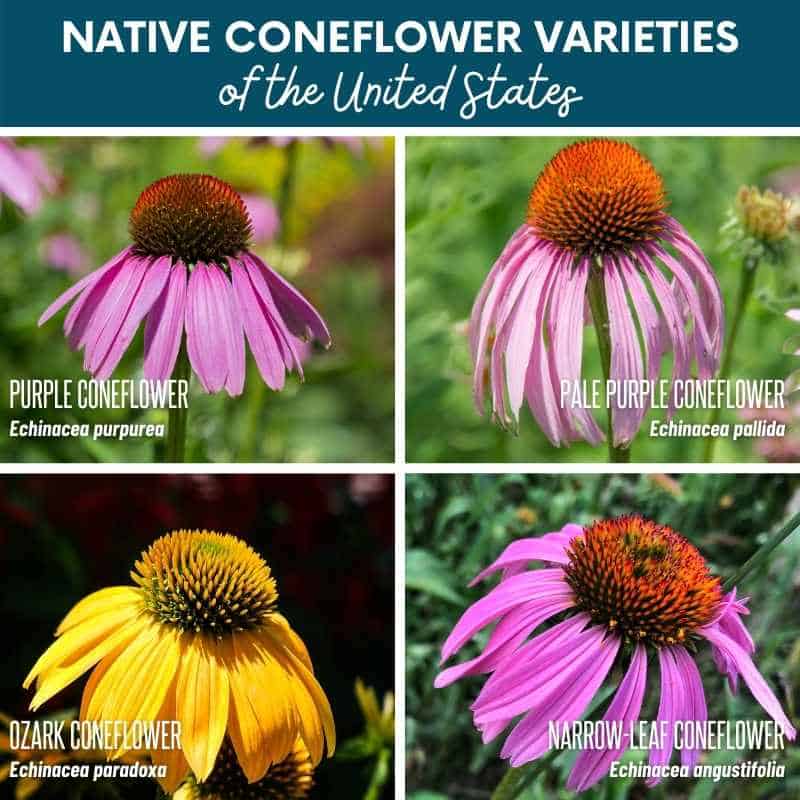
- Purple Coneflower (Echinacea purpurea) is native to the central and eastern United States. This variety blooms in mid to late summer, when its orange cone-shaped seed head is surrounded by lavender petals.
- Pale Purple Coneflower (Echinacea pallida) blooms in early summer with dark cones surrounded by thin, pale purple petals. This variety is also native to the central and eastern United States.
- Ozark Coneflower (Echinacea paradoxa) also blooms in early summer, but its petals are a bright, sunny yellow. Though only native to the Ozark region (Arkansas, Missouri, Oklahoma), it can also be grown in the upper Midwest and Northeast.
- Narrow-Leaf Coneflower (Echinacea angustifolia) is visually very similar to Echinacea pallida, with narrow petals around a brown cone. Unlike the pallida, however, the blooms range from pale pink to light purple, and the plant is native specifically to the dry prairies of the Great Plains.
Hybrid Coneflower Varieties
Most hybrid cultivars of coneflowers come from Echinacea purpurea. Many have the traditional bloom shape, with long petals draping down from a cone-shaped seed head. However, there are some hybrids that have double-decker flowers (sometimes called double blooms). While the pom-pom-like centers of double-decker blooms are fluffy and adorable, they are not a good choice for a pollinator garden. Those extra petals keep bees and butterflies from accessing the pollen and nectar.
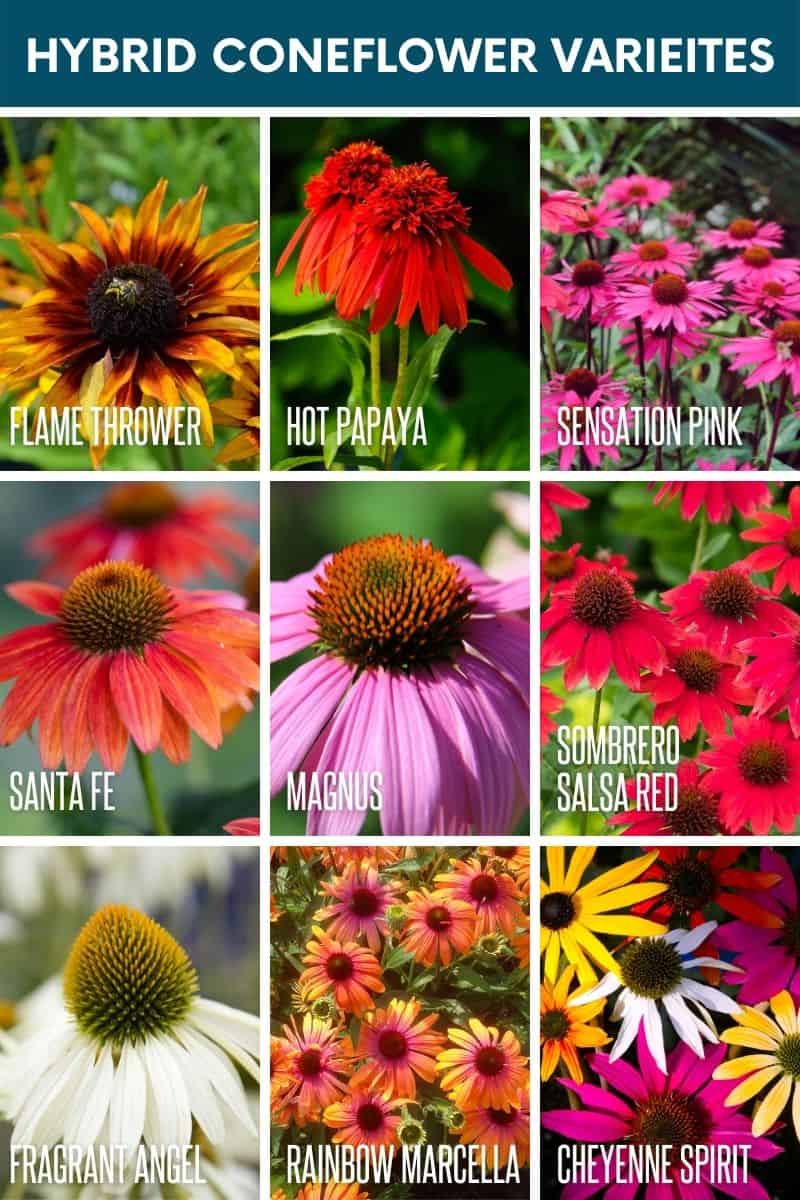
- Echinacea ‘Flame Thrower’ has two-toned orange and yellow flowers and a long blooming season. Deadhead blooms June through October to get more flowers out of the plant and allow the last blooms in the fall to remain on the plant to feed the birds over the winter. Hardy to zones 4-9.
- Echinacea ‘Hot Papaya’ has bright red flowers with pom pom-shaped centers. Hybrids with double blooms such as these are not a good choice for encouraging pollinators, as the extra petals make it harder for them to get to the pollen and nectar.
- Echinacea ‘Sensation Pink’ has, you guessed it, bright pink flowers with brown-orange cones. Sensation Pink is a dwarf coneflower with a compact habit, making it a good choice for a small space. Blooms in midsummer, hardy to zones 4-8.
- Echinacea ‘Santa Fe’ has a long blooming season (late summer to early fall) for its bright red-orange flowers. Deadhead spent blooms throughout the season to get the most flowers from your plant, but be sure to leave a few flowers intact at the end of the season to self-sow and feed the birds.
- Magnus Echinacea is hardy down to zone 3 and shows large pink to purple blooms from midsummer to fall.
- Echinacea Sombrero Salsa Red produces red blooms with brown cones from late spring into late summer. This variety has a compact habit, but still provides lots of flowers.
- Echinacea Fragrant Angel looks like a daisy, with white petals around a yellow cone. Hardy to zones 4-9, this cultivar blooms from midsummer to fall.
- Echinacea ‘Rainbow Marcella’ has blooms with vibrant petals that are raspberry-pink at the cone and ombre to orange tips. Blooming from early summer through early fall, this variety stays relatively small and is hardy to zones 4-9.
- Echinacea ‘Cheyenne Spirit’ isn’t just a single color plant, but a mix of red, yellow, orange, white, and pink plants. You’ll need to plant multiple plants to see all the colors (each plant is one single color).
Growfully Protip
It is not unusual for a colorful hybrid coneflower plant to revert back to the original coloring of Echinacea purpurea in later growing years. You might get a few years of the intense orange of a hybrid, but be prepared that it might switch to purple at some point.

